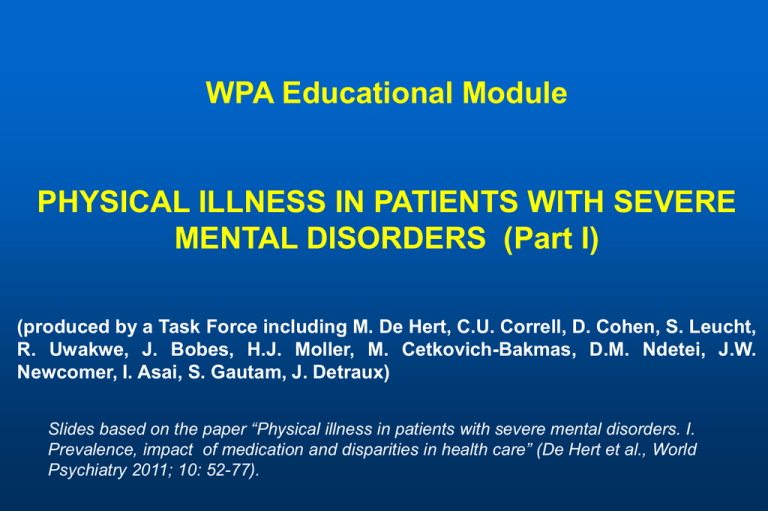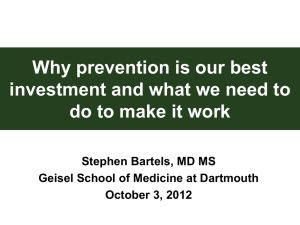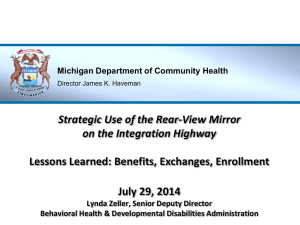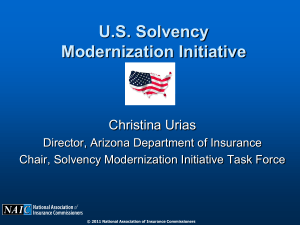
WPA Educational Module
PHYSICAL ILLNESS IN PATIENTS WITH SEVERE
MENTAL DISORDERS (Part I)
(produced by a Task Force including M. De Hert, C.U. Correll, D. Cohen, S. Leucht,
R. Uwakwe, J. Bobes, H.J. Moller, M. Cetkovich-Bakmas, D.M. Ndetei, J.W.
Newcomer, I. Asai, S. Gautam, J. Detraux)
Slides based on the paper “Physical illness in patients with severe mental disorders. I.
Prevalence, impact of medication and disparities in health care” (De Hert et al., World
Psychiatry 2011; 10: 52-77).
Background
People with severe mental illness (SMI) have excess
mortality, being 2 to 3 times higher compared to the
general population
60% of this excess mortality is due to physical illness
Physical illnesses are more prevalent and have a
greater impact in SMI patients
Several factors contribute to the poor physical health
of SMI patients:
– individual lifestyle choices
– disparities in health care access, utilization and provision
Physical illnesses with increased frequency in SMI patients
Bacterial infections and mycoses
Tuberculosis (+)
Viral diseases
HIV (++), hepatitis B/C (+)
Neoplasms
Obesity-related cancer (+)
Musculoskeletal diseases
Osteoporosis/decreased bone mineral density (+)
Stomatognathic diseases
Poor dental status (+)
Respiratory tract diseases
Impaired lung function (+)
Urological and male genital diseases
Sexual dysfunction (+)
Female genital diseases and pregnancy complications
Obstetric complications (++)
Cardiovascular diseases
Stroke, myocardial Infarction, arterial hypertension,
other cardiac and vascular diseases (++)
Nutritional and metabolic diseases
Obesity (++), diabetes mellitus (+), metabolic syndrome
(++), hyperlipidemia (++)
(++) very good evidence and (+) good evidence for increased risk
Adapted from Leucht et al. (Acta Psychiatr Scand 2007; 116:317-333).
Impact of obesity on physical health
MEDICAL CONDITION
RELATIVE RISK
Type 2 diabetes
>3
Dyslipidemia
>3
Respiratory difficulties
>3
Cardiovascular disease
> 2-3
Hypertension
> 2-3
Reproductive hormone abnormalities
> 1-2
Certain cancers (e.g. colon)
> 1-2
Adapted from Holt and Peveler (Diabetes Obes Metab 2009;11:665-679).
Assessment of overweight and obesity
Body mass index (BMI) (kg/m2)
– BMI 25 kg/m2 (Asian BMI 23 kg/m2) =
overweight
– BMI 30 kg/m2 (Asian BMI 25 kg/m2) = obesity
Waist circumference (WC)
– measuring abdominal or central adiposity
– more valid and reliable predictor than BMI of risk
for type 2 diabetes, cardiovascular disease and
other metabolic-related conditions
– lower cutoff points for Asians
Ethnicity-specific WC cutoff values
Europids, SubSaharan Africans,
Mediterranean and
Middle Eastern
populations
South Asians,
Japanese
Chinese, and ethnic
South and Central
Americans
Northern
Americans
Men
94 cm
90 cm
90 cm
102 cm
Women
80 cm
80 cm
82-85 cm
88 cm
Adapted from Alberti et al (Circulation 2009; 120: 1640-1645).
Obesity and SMI patients
Persons with SMI are, compared to the general population, at
increased risk for overweight, obesity and abdominal obesity
– schizophrenia
• 2.8 to 3.5 increased likelihood of being obese
• rates of obesity (BMI 30): 42-60% (Canadian and U.S. studies)
– major depression or bipolar disorder
• 1.2. to 1.5 increased likelihood of being obese
• rates of overweight or obesity: up to 68%
SMI obesity is associated with:
– lifestyle factors (e.g. poor diet)
– illness-related factors (e.g. depressive symptoms)
– treatment-related factors (e.g. weight liability of certain
psychotropic agents)
Obesity and psychotropics
Weight gain is a well established effect of some
psychotropics
– antipsychotic treatment
• hierarchy for risk of weight gain
• no antipsychotic is truly weight-neutral: all antipsychotics cause
significant weight gain in antipsychotic-naïve or first-episode patients
– antidepressants and mood stabilizers
• hierarchy for risk of weight gain
High inter-individual variability in medication-induced
weight gain suggests influence of genetic factors
Weight liability of psychotropic agents used in SMI
Drug class
Weight loss
Relatively weight
neutral
Weight gain
Antidepressants
Bupropion
Fluoxetine
Citalopram
Duloxetine
Escitalopram
Nefazodone
Sertraline
Venlafaxine
Substantial
Amitriptyline
Imipramine
Mirtazapine
Lamotrigine
Oxcarbazepine
Substantial
Lithium
Valproate
Anticonvulsants/
Mood stabilizers
Topiramate
Zonisamide
Intermediate
Nortriptyline
Paroxetine
Intermediate
Carbamazepine
Gabapentin
Antipsychotics
Aripiprazole (in pre-treated
individuals)
Molindone (in pre-treated
individuals)
Ziprasidone (in pre-treated
individuals)
Amisulpride
Aripiprazole
Asenapine
Fluphenazine
Haloperidol
Lurasidone
Perphenazine
Ziprasidone
Substantial
Chlorpomazine
Clozapine
Olanzapine
Intermediate
Iloperidone
Paliperidone
Risperidone
Quetiapine
Sertindole
Thioridazine
Zotepine
Metabolic syndrome (MetS) in the
general population
Main characteristics
– central obesity, hypertension, dyslipidemia, glucose intolerance or
insulin resistance
Large variations in prevalence estimates across definitions,
countries or regions, gender, ethnicity, and age groups
Relatively higher prevalence in North and South America than
other regions in the world
Associated with increased risk of developing different medical
conditions
– type 2 diabetes: 5-6-fold increased risk
– coronary heart disease: 3-6 fold increased risk
– certain cancers (e.g. colon cancer)
Working definitions of MetS
Criteria
WHO
(1998, 1999)
EGIR
(1999)
NCEP ATP III (2001,
2004)
AACE/ACE (2003)
IDF
(2005)
IDF & AHA/NHLBI
(2009)
Required factor
IGF, IFG or DM type 2, and/or
insulin resistance
insulin resistance or
hyperinsulinemia (highest
25%)
None
At least one of the specified
risk factors (e.g. obesity,
sedentary lifestyle, age >
40)
Central obesity (with
ethnicity-specific cutoff
values)
None
plus any 2 or more of following
plus any 2 of following
but any 3 or more of the
following 5 features
plus 2 or more of
following
plus any 2 of following
any 3 or more of following
Waist-to-hip ratio
>0.90 (men)
>0.85 (women),
WC 94 cm (men)
WC 80 cm (women)
WC 102 cm (men)
WC 88 cm (women)
BMI>25 kg/m2 or
WC > 102 cm (men)
WC > 89 cm (women)
(10-15% lower for nonCaucasians)
> 177 mg/dl (> 2.0 mmol/L)
150 mg/dl ( 1.7 mmol/L)
or elevated triglycerides Rx
>150 mg/dl
150 mg/dl ( 1.7 mmol/L)
or on lipid abnormality Rx
150 mg/dl ( 1.7 mmol/L)
(Rx for elevated
triglycerides is an alternate
indicator)
Additional factors
Obesity
and/or BMI>30 kg/m2
Triglycerides
150 mg/dl ( 1.7 mmol/L)
Elevated WC (population)
and country-specific
definitions as defined by IDF
and AHA/NHLBI until more
data are available
and/or
HDL-cholesterol
< 35 mg/dL(< 0.9 mmol/L)
(men)
< 39 mg/dL(< 1.0 mmol/L)
(women)
< 40 mg/dL (< 1.0 mmol/L
(men and women) or
dyslipidemia Rx
< 40 mg/dL (< 1.03
mmol/L)(men)
< 50 mg/dL (< 1.29
mmol/L(women) or reduced
HDL-cholesterol Rx
< 40 mg/dL (men)
< 50 mg/dL (women)
< 40 mg/dL (< 1.03
mmol/L)(men)
< 50 mg/dL (< 1.29
mmol/L(women) or lipid
abnormality Rx
< 40 mg/dL (< 1.0
mmol/L)(men)
< 50 mg/dL (< 1.3
mmol/L(women) or lipid
abnormality Rx
Blood pressure
160/90 mm Hg
(later modified as 140/90 mm
Hg)
140/90 mmHg or
hypertension Rx
130/85 mm Hg or
hypertension Rx
130/85 mm Hg
130/85 mm Hg or
antihypertensive Rx
130/85 mm Hg
(antihypertensive Rx in a
patient with a history of
hypertension is an alternate
indicator)
Glucose
IGT, IGF ( 110 mg/dL) ( 6.1
mmol/L), or DM type 2
IGT or IGF ( 110 mg/dL) (
6.1 mmol/L), (but not DM)
110 mg/dL ( 6.1 mmol/L),
(includes DM)
(later modified as 100
mg/dL) ( 5.6 mmol/L), or on
elevated glucose Rx
100-125 mg/dl
100 mg/dL ( 5.6 mmol/L)
or previously diagnosed type
2 DM
100 mg/dL ( 5.6 mmol/L)
(Rx of elevated glucose is an
alternate indicator)
Other
Microalbuminuria (urinary albumin
excretion rate 20 μg/min or
albumin: creatinine ratio 20 mg/g
(later modified as 30 mg/g)
MetS in SMI patients
People with SMI exhibit a higher MetS prevalence than their
peers in the general population across the world
– schizophrenia: 19.4-68%
– schizoaffective disorder: 42%
– bipolar disorder: 22-30%
Lifestyle and behavioural patterns (smoking, physical
inactivity, dietary habits) play important roles in the
prevalence of the MetS in these populations
MetS remains underdiagnosed and undertreated among
people with SMI. The proportion of patients not receiving tests
for assessing metabolic risk factors is high
Approximate relative likelihood of metabolic
disturbances with antipsychotic medication
Medication
Risk for MetS
Chlorpromazine
Clozapine
Olanzapine
High (?, limited data)
High
High
Quetiapine
Moderate
Amisulpride
Iloperidone
Paliperidone
Risperidone
Sertindole
Mild
Mild (?, limited data)
Mild
Mild
Mild
Aripiprazole
Asenapine
Haloperidol
Lurasidone
Perphenazine
Ziprasidone
Low
Low (?, limited data)
Low
Low (?, limited data)
Low
Low
Adapted from Hasnain et al (Curr Diab Rep 2010;10: 209-216).
Disparities in health care of MetS in
SMI patients
Even after the FDA (Food and Drug Administration) and
the ADA (American Diabetes Association)/APA (American
Psychiatric Association) recommendations for novel AP,
the frequency of baseline glucose and lipid testing
showed little change
Publication (2004) of guidelines recommending metabolic
screening at baseline and at 3 months has had no
discernable effect on screening practice
Morrato et al (Arch Gen Psychiatry 2010; 67:17-24).
Diabetes mellitus (DM)
Prevalence
– 3-4% of the world’s population have DM
– 70% of people with DM live in developing countries (more than 80% in 2030)
Severe consequences
– blindness, renal failure, amputation, cardiovascular disease, reduced life
expectancy ( 10 years)
Well-defined biological and behavioral risk factors
– overweight and obesity (RR: 4.1-17.5)
– physical inactivity (RR: 1.1-2.2)
– other behavioral risk factors (e.g. diets low in whole grains and other sources
of fibre, smoking)
Combination of moderate weight loss, increased physical activity and
dietary advice can lead to a 60% reduction in DM incidence
DM in SMI patients
Prevalence of DM in SMI patients is higher compared
with the general population
– schizophrenia, bipolar disorder and schizoaffective disorder: 2-3
times higher
– depression: 1.2-2.6 times higher
Increase in ‘well-established’ DM risk factors
probably accounts for much of the increased risk in
these patients
DM and psychotropics
Antipsychotics (AP)
– diabetogenic risk 1.3 fold higher in people with schizophrenia taking
atypical AP compared with those receiving conventional AP
– risk DM-related adverse events differs between atypical AP (olanzapine,
clozapine > risperidone, quetiapine > aripiprazole, ziprasidone)
Antidepressants (AD)
– specific data on the risk of DM associated with the use of AD are sparse, but
increasing
– concurrent use of tricyclic AD and SSRIs, long-term use for both tricyclic
AD and SSRIs in at least moderate daily doses, as well as the use of AD
medication in high-risk patients is associated with increased DM risk
Mood stabilizers
– valproate has elevated risk for the development of insulin resistance
Disparities in health care of DM in SMI patients
Evidence that diabetes patients with mental health
conditions are less likely to receive standard levels
of diabetes care
–
–
–
–
–
no hemoglobin A(1c) testing: RR=1.24
no LDL-cholesterol testing: RR=1.25
no eye examination: RR=1.05
poor glycemic control: RR=1.32
poor lipaemic control: RR=1.17
Screening rates for metabolic abnormalities in
people with SMI remain low, which may lead to
prolonged periods of poor glycemic control
Frayne et al (Arch Intern Med 2005; 165(22): 2631-2638).
Diabetic ketoacidosis (DKA)
Potentially fatal condition related to metabolic stress, such as
infection, trauma, myocardial infarction or stroke
Symptoms include: increased thirst and urination, nausea and
vomiting, abdominal pain, poor appetite, unintended weight
loss, lethargy, confusion, coma
Incidence of DKA nearly or more than 10-fold greater in those
with schizophrenia compared to the general population
Cases of DKA have been reported with all atypical
antipsychotics, and with the conventional antipsychotic
chlorpromazine
Mortality of reported cases of DKA varies between 15.4% and
48%
Cohen and Correll (J Clin Psychiatry 2009; 70: 765-766); Henderson et al (J Clin Psychiatry 2007; 68: 533541).
Cardiovascular diseases (CVD)
Any disease that affects the cardiovascular system, with
coronary heart disease (CHD) and cerebrovascular disease
being the principal components
Risk factors: smoking, obesity, hypertension, raised blood
cholesterol, diabetes, unhealthy diet, physical inactivity and low
socioeconomic status
Prevalence
– accounts for 17.1 million or 29% of total worldwide deaths
– 82% of worldwide CVD deaths take place in developing countries
due to global trade and food market globalization, increased
obesity, physical inactivity and tobacco consumption, and less
access to effective and equitable health care services
Economic development and summary prevalence of CVD risk
factors in WHO subregions
Poorest countries in
Africa, America, SouthEast Asia, Middle East
Body Mass Index
Better-off countries in
America, Europe, SouthEast Asia, Middle East,
Western Pacific
Developed countries of
Europe, North America,
Western Pacific
19.9-26.0
22.9-26.0
23.4-26.9
11-23
15-24
17-20
Low fruit and vegetable
intake per day (grams)
240-360
190-350
290-450
Blood pressure (mean
systolic pressure, mm
Hg)
125-133
124-133
127-138
Mean cholesterol
(mmol/l)
4.8-5.1
4.6-5.8
5.1-6.0
Physical activity
(% with no physical
activity)
World Health Organization. World Health Report 2002: reducing risks, promoting healthy life. Geneva: World
Health Organization, 2002.
CVD in SMI patients
Patients with SMI are at significantly higher risk for
cardiovascular morbidity and mortality than their
counterparts in the general population
– schizophrenia and bipolar disorder: up to 3-fold higher
– depression: up to 5-fold higher
Excess CVD is multifactorial and likely includes
genetic and lifestyle factors as well as disease
specific and treatment effects
Estimated prevalence and relative risk (RR) of modifiable CVD
risks factors in schizophrenia and bipolar disorder compared
to the general population
Modifiable risk factors
Schizophrenia
Prevalence
RR
Bipolar Disorder
Prevalence
RR
Obesity
45-55%
1.5-2
21-49%
1-2
Smoking
50-80%
2-3
54-68%
2-3
DM
10-15%
2-3
8-17%
1.5-3
Hypertension
19-58%
2-3
35-61%
2-3
Dyslipidemia
25-69%
5
23-38%
3
MetS
37-63%
2-3
30-49%
1.5-2
RR = relative risk
Correll (CNS Spectr 2007;12 (Suppl 17):12-20,35); De Hert et al (World Psychiatry 2009; 8: 15-22).
Coronary heart disease (CHD) in SMI patients
Will become the leading cause of death in developing countries
and emerge as the leading cause of death in the world during the
21st century
Risk of CHD higher in SMI patients
– schizophrenia: 2 to 3.6-fold increased risk
– bipolar disorder: 2.1-fold increased risk
– major affective disorder: 1.7 to 5-fold increased risk
Depression increases risk of death or nonfatal cardiac events
approximately 2.5-fold in patients with CHD
Cerebrovascular disease (CVD) in SMI
patients
Risk of CVA higher in SMI patients
– schizophrenia: 1.5 to 2.9- fold increased risk
– bipolar disorder: 2.1 to 3.3-fold increased risk
– major affective disorder: 1.2 to 2.6-fold increased
risk
Obesity, diabetes, CVD as well as depressive
symptoms are recognized as risk factors for CVA
CVD and psychotropics
Antipsychotics (AP)
– in addition to indirect, weight gain and obesity related
mechanisms, there appears to be a direct effect of AP that
contributes to the worsening of CVD risk
– higher AP doses predict greater risk of mortality from CHD and
CVA
Antidepressants (AD)
– SSRIs appear safe in cardiac populations, with few cardiac
side effects
– studies have found an increased risk of adverse cardiac events
(10% increase heart rate, orthostatic hypotension, slow cardiac
conduction, increased risk of arrhythmias) in patients using
tricyclics
Mood stabilizers
– lithium generally can be safely used in cardiac patients
Sudden cardiac death (SCD) and psychotropics
Patients with schizophrenia are three times as likely to
experience SCD as individuals from the general population
Dose-related increased risk of SCD found for both
conventional and atypical antipsychotics
– 1.31 vs. 1.59 (low dose, CPZ equivalents <100 mg)
– 2.01 vs. 2.13 (moderate dose, CPZ equivalents 100-299 mg)
– 2.42 vs. 2.86 (high dose, CPZ equivalents 300 mg)
Dose-related increased risk of SCD found in current users of
tricyclic antidepressants
Ray et al (N Engl J Med 2009; 360:225-235).
QTc-prolongation and psychotropics
QTc values > 500 msec or increase of 60 msec compared with drug-free
baseline put patients at significant risk of torsade de pointes (TdP),
ventricular fibrillation and SCD
Antipsychotics associated with a greater risk of QTc prolongation
– pimozide, thioridazine, and mesoridazine
– sertindole (?) and ziprasidone (?)
• ZODIAC study (n = 18,154): no significant difference in risk of SCD between ziprasidone
and olanzapine treated patients with schizophrenia
• SCoP study (n=9,858): no significant differences between sertindole and risperidone
recipients in cardiac events, including arrhythmias, requiring hospitalization
Cases of TdP
– reported with thioridazine, haloperidol, ziprasidone, olanzapine and tricyclic
antidepressants
– no cases of TdP have been reported with SSRIs
– no cases of lithium-induced TdP
Disparities in health care of CVD in SMI patients
SMI patients have the least chance of receiving many
specialized interventions or circulatory medications
– people with schizophrenia are not adequately screened and treated
for dyslipidemia (up to 88% untreated) and hypertension (up to 62%
untreated)
– significant deficit in the prescription of statins for schizophrenic
patients
– low rates of surgical interventions, such as stenting and coronary
artery bypass grafting
Lack of seeking medical care by SMI patients themselves,
even during acute cardiovascular syndromes
HIV positivity in SMI patients
Prevalence in people with SMI is generally higher than in the general
population, but varies substantially (1.3-23.9%), probably reflecting a
different degree of prevalence of HIV positivity in different parts of the
world
High frequency of substance abuse, sexual risk behaviors (e.g. sex without
a condom, trading sex for money and drugs) and a reduced knowledge
about HIV-related issues contribute to the high HIV prevalence
Fewer than half of the SMI patients are tested in the past year
Mental health workers have a poor knowledge about HIV/AIDS in people
with SMI and require training to provide skills for the promotion of sexual
health and HIV prevention
Antipsychotic treated schizophrenic patients infected with HIV and on
highly active antiretroviral therapy are at particularly high risk for
developing MetS and ultimately cardiovascular disease
Hepatitis in SMI patients
Across different continents, persons with SMI have
markedly elevated rates of hepatitis virus infection
compared to the general population
Overall, an estimated 20-25% of persons with SMI are
infected with hepatitis C virus
Most common transmission risks for persons with SMI are
drug-use behaviors and sexual behaviors related to drug
use
Patients with mental illness are less likely to receive
antiviral therapy
Respiratory diseases in SMI patients
Tuberculosis
– higher incidence among patients with schizophrenia compared with the
general population
– in some countries still occurs so frequently that mental hospitals have
special wards for people with both tuberculosis and schizophrenia
Pneumonia
– schizophrenia is associated with a 1.4-fold greater risk of acute
respiratory failure and a 1.3-fold greater risk of mechanical ventilation
Chronic obstructive pulmonary disease
– prevalence is significantly higher among those with SMI than
comparison subjects
• chronic bronchitis: schizophrenia (15%), bipolar disorder (25%)
• asthma: schizophrenia (16%), bipolar disorder (19%)
Cancer risk in SMI patients
Studies exploring relationship between SMI and all cancer types together
have shown conflicting results
– schizophrenic patients: decreased, higher or no different cancer risk
compared to general population
– bipolar disorder: no or slightly elevated risk
Discrepancy of results possibly due to various confounding factors
artificially lowering the rates of diagnosed and reported cancer in SMI
populations
– SMI patients are less likely to receive routine cancer screening
– SMI patients have a shorter life expectancy and may die from cardiovascular
reasons before reaching the expected age of death from cancer
– protective effects of disease or antitumour properties of medication
Cancer risk and psychotropics
Assumption has been made that exposure to prolactin-raising
dopamine antagonists could result in breast cancer
– current study database on antipsychotics and breast cancer risk is
very limited
– the majority of the few studies considering risk of breast cancer in
patients treated with conventional antipsychotics did not uncover an
increased risk of breast cancer, an exception being the cohort study
by Wang et al (2002)
Osteoporosis in SMI patients
Schizophrenia: untreated patients have an increased risk of
developing osteoporosis
– due to the disease itself
– due to risk factors related to their lifestyle (e.g. smoking,
reduced physical activity, alcohol abuse, vitamin D and
calcium deficiency, polydipsia)
Depression: most studies have found low bone mineral density in
patients with depressive symptoms or major depressive disorder
– due to physiologic changes
– due to the adoption of poor health behaviours
Osteoporosis and psychotropics
Osteoporosis or low bone mineral density (BMD)
– antipsychotics: clinical data are limited and contradictory.
However, hyperprolactinemia with associated hypogonadism
may be a risk factor
– antidepressants: majority of studies report that the use of
SSRIs is associated with low BMD
Osteoporotic fractures
– antipsychotics: conflicting results exist. Some studies report
higher prevalence rates in patients with chronic schizophrenia,
entirely or partly independent of the use of antipsychotics;
other studies found significant increases (OR=1.2-2.6)
– antidepressants: SSRIs are associated with high risk (OR= 1.5)
– mood stabilizers: lithium is associated with lower fracture risk
(OR= 0.6)
Sexual dysfunction in SMI patients
Sexual dysfunction in SMI patients receives little attention from
clinicians, having a significant negative impact on patients' satisfaction
with treatment, adherence, quality of life and partner relationships
Sexual dysfunction in SMI patients is, compared to normal controls, more
frequent
– schizophrenia: 30-80% of women and 45-80% of men
– depression: up to 70%
Patients with SMI are likely to engage in high-risk sexual behavior,
putting them at risk of sexually transmitted diseases. However, sexual
health education for these people tends to produce a reduction in sexual
risk behavior
Sexual dysfunction and psychotropics
Antipsychotics (AP)
– relative impact of atypical AP on sexual dysfunction can be
summarized as: risperidone > olanzapine ziprasidone > clozapine
quetiapine > aripiprazole
– conventional AP cause less sexual dysfunctions than risperidone but
more than the other atypical AP
Antidepressants (AD)
– AD therapy (except for mirtazapine, nefazodone and bupropion)
frequently induces or exacerbates sexual dysfunction, which occurs
in approximately 50% of patients
– Although sexual dysfunction has been reported with all classes of AD,
SSRIs are associated with higher rates of sexual dysfunction
(between 30% and 60%)
Pregnancy and psychotropics
Antipsychotics
– until today, no definitive association has been found between the use of
AP during pregnancy and an increased risk of birth defects or other
adverse outcomes
– most available data with haloperidol
Antidepressants
– SSRIs and, possibly, SNRIs have been associated with preterm labor,
respiratory distress, serotonin rebound syndrome, pulmonary
hypertension and feeding problems in the neonate
Mood stabilizers
– a number of mood stabilizers have been associated with fetal
malformations, including carbamazepine and valproate
Stomatognathic diseases
All studies without exception report poor dental health of people with SMI
Poor dental health leads to functional difficulties in SMI patients (34%
report that oral health problems make it difficult for them to eat)
Factors influencing oral health include: type, severity, and stage of mental
illness; lifestyle (e.g. smoking), effects of medication (dry mouth,
carbohydrate craving); attitudes and knowledge of dental health teams
concerning mental health problems
Antipsychotics, antidepressants and mood stabilizers all cause
xerostomia, leading to caries, gingivitis and periodontal disease
Oral health is a frequently disregarded health issue among SMI patients.
Studies report low rates of dental examination within the past 12 months
(43% -77%)
Acknowledgements
This set of slides is part of the WPA programme aiming to raise
the awareness of the prevalence and prognostic implications of
physical diseases in persons with severe mental disorders. The
support to the programme of the Lugli Foundation, the Italian
Society of Biological Psychiatry, Pfizer and Bristol-Myers Squibb
is gratefully acknowledged.










